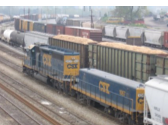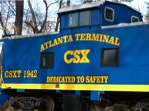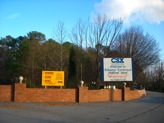





Tilford Yard: built in 1957, one of CSX’s major hump terminals handles more than 40 trains per day.
Howells Yard: an industrial serving yard with 15 tracks, includes the Transflo facility which receives bulk commodities and transfers them to trucks for local distribution. Serving yard for Georgia Power Company’s McDonough-Atkinson plant, which receives unit coal trains an average of three times a week.
Hulsey and Fairburn Intermodal Terminals: Hulsey Yard in downtown Atlanta and Fairburn, south of the city, handle a growing intermodal business. Intermodal refers to containers or trailers on flat cars, a service that combines truck-competitive standards with rail economies. Fairburn, works in conjunction with Hulsey.

The Western and Atlantic Railroad (W&A) is a historic railroad that operated in the southeastern United States from Atlanta, Georgia to Chattanooga, Tennessee.
It was founded on December 21 1836 as the Western and Atlantic Railroad of the State of Georgia. The line is still owned by the State of Georgia from Atlanta to CT Tower in Chattanooga.
This line is famous because of the Andrews Raid (commonly referred to as the Great Locomotive Chase), which took place on the W&A during the American Civil War on the morning of April 12, 1862.
Leasing
Through 1870, it was called the State Road, and was operated directly by the state under a superintendent appointed by and reporting to the governor of Georgia. On December 27 of that year, operations were transferred to the Western & Atlantic Railroad Company, a group of 23 investors including Georgia's wartime governor Joseph E. Brown, who leased it (both tracks and rolling stock) from the state for $25,000 per month. This expired exactly 20 years later on the same date in 1890, when the Nashville, Chattanooga & St. Louis (NC&StL) leased it for 29 years. Unfortunately, the railroad that was handed over to the Nashville, Chattanooga and St. Louis Railway was in very poor condition. The locomotives that were transferred to the Nashville, Chattanooga and St. Louis Railway consisted only of those listed on the 1870 lease as property of the State. All of the new ten-wheel locomotives purchased by Gov. Brown's Western and Atlantic Railroad Company were sold to other railroads. While most of the passenger equipment turned over was usable, almost all of the locomotives were condemnable and all of the freight cars were scrapped. The value of the locomotives was something that would be argued over for some twenty years. A major change made to the new lease in 1890 stipulated that all improvements made to the road by the lessee would become property of the state at the termination of the lease. Included in the definition of improvements were modifications to the facilities, right of way and new equipment purchased for use over that line including but not limited to passenger cars, freight cars and locomotives. As it turned out, the Nashville, Chattanooga and St. Louis Railway would continue to hold the lease to the Western and Atlantic Railroad of the State of Georgia until it was absorbed by its parent company, the Louisville and Nashville Railroad which was itself owned by the Atlantic Coast Line-one of the principal railroads in the Family Lines System and later CSX Transportation which continues to operate the line as the Western and Atlantic Subdivision. CSXT signed the current 99 year lease on the W&A from the State of Georgia in 1986.
After being captured by the Union in mid-1864 and until the end of the war in 1865, the line was briefly operated by United States Military Railroad. (USMRR).


Tilford Yard 2006




